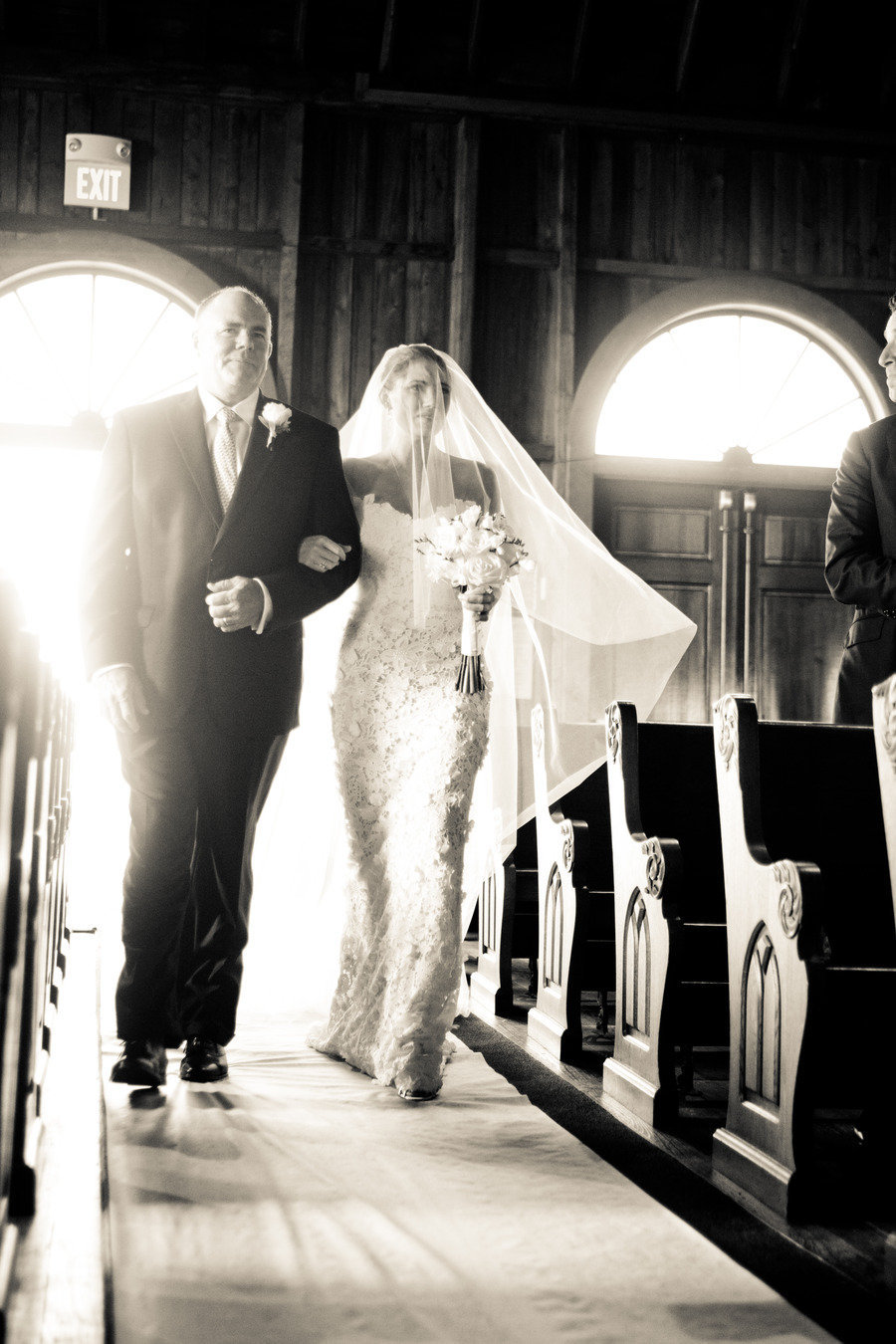With your wedding day fast approaching (!), it’s time to perfect some day-of details. Once you've figured out the order of your wedding ceremony, you can move on to how everyone will enter the ceremony and take their places up front. The processional (aka the entrance of the wedding party) marks the start of the ceremony, and it can be one of the most memorable parts of the whole wedding. From choosing the music to who walks down the aisle when, we’ve got everything you need to prepare for a smooth ceremony.

Photo by Kristina Adams Photography
How Do You Determine Wedding Processional Order?
Some couples choose to have an intimate processional and walk hand in hand down the aisle, just the two of them. Others may have an entire posse of friends and family come down the aisle. Use these traditional processional orders as a starting point, then put your personal spin on them so your wedding processional order is just right for you.
TRADITIONAL CATHOLIC WEDDING PROCESSIONAL ORDER
For a Catholic wedding, the wedding party should enter the ceremony venue in the following order, with men on the right and women on the left when walking down the aisle together. At the altar, the groom and groomsmen stand on the right side, the bride and her bridesmaids stand on the left, and the priest is in the center.
1. Priest, Groom, and Best Man
The priest, followed by the groom and best man, enters the ceremony from the side of the venue, and they all take their places at the altar.
2. Bridesmaids and Groomsmen
The bridesmaids and groomsmen walk down the aisle in pairs, starting with the attendants who will stand farthest from the bride and groom. Once the pair reaches the end of the aisle, they part ways. The first groomsman turns right and takes his place farthest from the groom, and the first bridesmaid turns left and takes her place farthest from the bride.
3. Maid of Honor/Matron of Honor
Before she walks down the aisle, she should do a final check to make sure the bride's veil, dress, and train look perfect (just one of her maid of honor duties). Then she walks down the aisle and stands on the bride’s left. She might hold the bride's flower bouquet during the ceremony, returning it to her after the kiss.
4. Flower Girl and Ring Bearer
The children can walk together, or the ring bearer can enter before the flower girl. Traditionally, the ring bearer carries the wedding rings tied to a pillow (or ring decoys, if he's too little to be trusted with the real things; in that case, the best man would hold the actual rings). The flower girl carries a basket of flower petals, which she scatters as she walks, or a small bouquet of flowers. Once they've reached the front, they may be seated with their parents.
5. Bride and Father of the Bride
The bride is escorted down the aisle by her father. The father escorts her to the end of the aisle and then takes his seat in the first row next to the bride's mother.

Photo by Alba Turnbull
TRADITIONAL CHRISTIAN CEREMONY
The wedding party should enter the ceremony venue in the order listed below, with men on the right and women on the left when walking down the aisle together. At the altar, the groom and groomsmen stand on the right side, the bride and her bridesmaids stand on the left, and the officiant is in the center.
1. Officiant
The officiant is usually honored with the opening spot in the processional. However, some couples prefer the officiant to enter the ceremony from the side of the venue, leading the groom and groomsmen to their place at the altar.
2. Groom
Traditionally, he walks down the aisle solo, but some grooms prefer walking down the aisle escorted by both parents. Other grooms prefer to enter the ceremony from the side of the venue following the officiant and followed by the groomsmen.
3. Best Man
He walks down the aisle solo, following the groom.
4. Groomsmen
They walk down the aisle solo or in pairs. They take their places up front, with the first groomsman standing farthest from the groom.
5. Bridesmaids
They walk down the aisle solo or in pairs. They take their places up front, with the first bridesmaid standing farthest from the bride.
6. Maid of Honor/Matron of Honor
Before she walks down the aisle, she should do a final check to make sure the bride's veil, dress, and train look perfect. Then she walks down the aisle and stands on the bride’s left.
7. Flower Girl and Ring Bearer
The children can walk together, or the ring bearer can enter before the flower girl. Once they've reached the front, they may be seated with their parents.
8. Bride and Father of the Bride
The bride is escorted down the aisle by her father. After he gives her away, he lifts her veil, gives her a kiss, then takes his seat in the first row next to the bride's mother.
9. Parents of the Groom and Mother of the Bride
Right before the ceremony is about to begin, the parents of the groom and the mother of the bride should take their seats. The groom's parents take their seats in the first row, on the right side. The mother of the bride, escorted by an usher or family member, takes her seat in the first row, on the left side.

Photo by Aubrey Oothout Photo
TRADITIONAL JEWISH CEREMONY
For a Jewish ceremony, the wedding party should walk down the ceremony aisle in the following order, with men on the left and women on the right when walking down the aisle together.
1. Cantor and/or Rabbi
They take their places beneath the chuppah (a traditional Jewish wedding canopy), standing in the center.
2. Grandparents of the Bride
They walk down the aisle and take their seats in the first row, on the right side.
3. Grandparents of the Groom
They walk down the aisle and take their seats in the first row, on the left side.
4. Groomsmen
They typically walk down the aisle in pairs and take their places up front, on the left alongside the chuppah, with the first groomsman taking his place farthest from the groom.
5. Best Man
He walks down the aisle solo and stands at the groom's side during the ceremony, either beneath or alongside the chuppah.
6. Groom & Parents
He walks down the aisle escorted by his parents, who stand with the couple under the chuppah, on the left side, for the duration of the ceremony.
7. Bridesmaids
They walk down the aisle one by one or in pairs. They take their places up front, on the right alongside the chuppah, with the first bridesmaid taking her place farthest from the bride.
8. Maid of Honor/Matron of Honor
Before she walks down the aisle, she should do a final check to make sure the bride's veil, dress, and train look perfect. Then she walks down the aisle and stands to the right of the bride during the ceremony, either beneath the chuppah or right alongside.
9. Flower Girl & Ring Bearer
The children can walk together, or the ring bearer can enter before the flower girl. Once they've reached the front, they may be seated with their parents.
10. Bride & Parents
She walks down the aisle escorted by her parents. It is customary for the parents of the bride to stand with the couple under the chuppah, on the right side, for the duration of the ceremony.
SAME-SEX CEREMONY
The wedding party should enter the ceremony venue in the following order, with Partner #1's attendants on the left and Partner #2's attendants on the right when walking down the aisle together. At the front, Partner #1 and attendants stand on the left side while Partner #2 and attendants stand on the right, with the officiant positioned in the center.

Photo by Bridgette Ibbotson Photography
1. Officiant
The officiant can be given the opening spot in the processional, or they can enter the ceremony from the side of the venue to take their place at the altar.
2. Wedding Party
Wedding party members—one attendant from each side—walk down the aisle in pairs, starting with the attendants who will stand farthest from the couple. Once they reach the end of the aisle, Partner #1's attendant takes their place farthest from Partner #1, and Partner #2's attendant takes their place farthest from Partner #2.
3. Best People
Partner #1's Best Person and Partner #2’s Best Person walk down the aisle together. Alternatively, each person can walk down the aisle solo. Once they reach the end of the aisle, Partner #1's attendant will take their place next to Partner #1 and Partner #2's attendant will take their place next to Partner #2.
4. Flower Person and Ring Bearer
The littlest attendants can walk together as a pair or one by one. Once they've reached the front, they may be seated with their parents for the duration of the ceremony.
5. Partner #1 and Parent(s)
Partner #1 walks down the aisle escorted by their parent(s) and takes their position up front. Their parents will then take their seats in the first row, on the left side.
6. Partner #2 and Parent(s)
Partner #2 walks down the aisle escorted by their parent(s) and takes their position up front. The parents then take their seats in the first row, on the right side.
NON-TRADITIONAL CEREMONY PROCESSIONAL IDEAS
If none of these processional orders are quite right for your ceremony, feel free to use one as a starting point, but adapt the order (or toss the rule book out completely!) to create a wedding ceremony that is unique and meaningful to you and your families. Here are some creative, nontraditional ways to personalize your wedding processional:
- Groom's grandparents walk down the aisle first (parental side followed by maternal side) and take their seats in the first or second row on the right side. The bride's grandparents go next (parental side followed by maternal side) and take their seats in the first or second row on the left side.
- Both sets of parents or parental figures escort their children down the aisle.
- Wedding attendants walk down the aisle in pairs, with one attendant from Partner #1's side walking alongside an attendant from Partner #2's side. Then Partner #1 enters, escorted by their parent(s), followed by Partner #2, escorted by their parent(s).
- Parents of Partner #1 walk down the aisle, followed by parents of Partner #2; then, Partner #1 and Partner #2 walk down the aisle together.
- Partner #1 waits at the altar/chuppah and meets Partner #2 halfway down the aisle, then they walk the rest of the aisle together arm in arm.
- Each person in the couple walks down the aisle solo.
- Grandparents stand (or sit) underneath the chuppah along with parents if there's room.
- Wedding attendants walk down the aisle but sit once they’ve reached the end.
- Skip the walk down the aisle entirely and enter the ceremony space from the side or back door once the ceremony begins. Or mingle with guests and then make your way to the front once the ceremony begins.

Photo by Sasha Reiko Photography
FREQUENTLY ASKED QUESTIONS
Who walks down the aisle with the mother of the bride?
The mother of the bride is traditionally escorted by her son, if she has one. Otherwise, any close male relative, the best man, or a groomsman walks with the mother of the bride during the processional.
Are there alternatives to fathers walking down the aisle?
The bride can walk down the aisle with her mother, both parents, step-parent(s), grandparent(s), or her children.
How can I switch up the traditional processional order?
You can have any combination of parents or stepparents accompany the bride and groom down the aisle, have the wedding party enter in pairs or one by one, or even have the bride and groom walk down the aisle together. It’s your wedding!

Photo by Afrik Armando
How do I choose wedding processional music?
Start with considering the mood you want to create and the ambiance of the venue. Think about a song or music that’s meaningful to you as a couple. You can also ask your officiant for input. Here are some great ideas for your wedding processional music.
What’s the history of the wedding processional order?
The history of the wedding processional does not have a single origin story like other common wedding traditions. For the most part, it was a religious ceremony that created the organized order. Outside of religion, the main tradition was for the father to walk his daughter down the aisle and give her away to the groom.
Looking for more guidance on how to plan and create your wedding ceremony? We've put together in-depth guides to every aspect of the ceremony:






